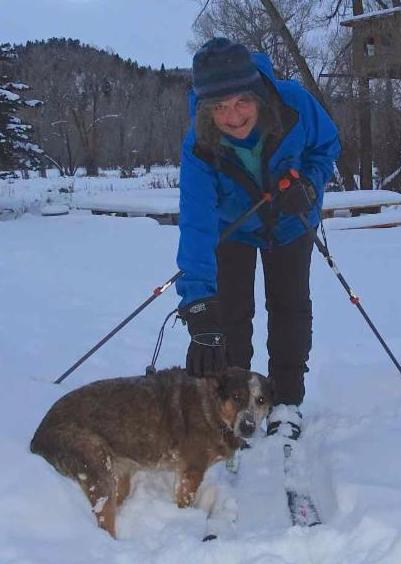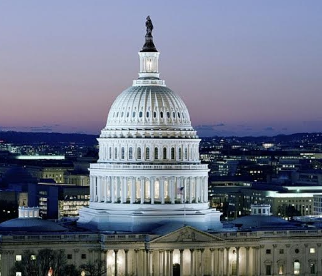March 2018 Newsletter – Who Saved Me from the Moose?
Hello!

Grace saved me from skiing into a moose
I hope you are enjoying the winter. I love cross country skiing and am very fortunate to have enjoyed ski/work trips to Mammoth Lakes and Jackson Hole/Denver. On my birthday I was skiing in Wyoming near the Tetons with my friend’s dog Grace (see picture of Arlene and Grace in the snow) and lost in my thoughts about persistent pollutants such as highly fluorinated chemicals. When Grace began barking loudly, I looked up to see two huge moose towering just ahead on the trail. I abruptly changed course making a large circle around the vigilant moose who were staring at me intently all the way. I have heard that some Alaskans consider moose more dangerous than bears and am grateful to Grace for keeping me safe.
And I am very happy that the world is becoming safer as word is spreading about reducing the use of highly fluorinated chemicals. These persistent and harmful chemicals are used in many consumer products for their oil and water repellency properties. However, they make their way out of products and end up in all of us.
To learn more about these so-called “Teflon Toxins”, you can watch our short video here or read Sharon Lerner’s outstanding journalism here.
For my ski trips, I wore a new Royal Robbins jacket with a label proclaiming “No fluorinated chemicals” and the cross country ski center at Mammoth has stopped using all fluorinated ski waxes. And other manufacturers are using less and less of these problematic chemicals – good for our health and environment – and even the moose!
Our Institute is contributing by working with food contact paper, carpet, and outdoor product manufacturers to reduce these persistent pollutants and our science-based approach is proving amazingly successful. Other big news is that the California Department of Toxic Substances Control is proposing to list carpets & rugs containing any highly fluorinated chemicals as priority products for regulation. Washington State’s Healthy Food Packaging Act passed their House & Senate by a large margin, banning paper food packaging containing any member of this class of chemicals.
To support our work to reduce such toxics in our products and planet, our Institute is looking for a full-time Administrative Specialist for our North Berkeley office. Please pass on the link to our jobs page to those who might be interested.
You might enjoy my new and improved www.ArleneBlum.com website with memorable photos from my expeditions worldwide that you can freely download. Also, you can view the PPT talks here from our February 2018 Flame Retardant and Beyond Symposium at UC Berkeley.
Please read on for some memorable pieces excerpted from our recent monthly newsletters and do let me know if you might want to hear from us each month in addition to quarterly.
Arlene and the Green Science Team
You probably already know to purchase water bottles labeled that they are free of bisphenol A (or BPA). But did you also know that this hormone disrupting chemical, and its regrettable substitute BPS, are used in cash register receipts?
The Ecology Center tested 207 store receipts and found that 93% contained either BPA or BPS. Since these chemicals, which give receipts their distinctive powdery texture, are not bound to the paper, they can be absorbed through the skin and enter the bloodstream. One study showed that over 88% of human exposure to BPS was through handling receipts. And bisphenol-laden receipts in landfills can leach into ground water, entering our food and water supply.
While there are detectable levels of BPA and BPS in most humans, cashiers, who handle a large number of receipts each day, are the most vulnerable to bisphenol’s adverse health effects. Exposure has been linked to obesity, heart disease, diabetes, decreased fertility and endocrine disruption. These adverse health impacts can be reduced by frequent handwashing or wearing gloves while handling receipts treated with bisphenols.
Environmental Injustice: The Contamination of the Arctic
 Arctic indigenous peoples have some of the highest exposures to persistent and toxic chemicals of any population on earth. At our February 9 meeting, Pam Miller, the executive director of Alaska Community Action on Toxics (ACAT), explained how the Arctic is a hemispheric sink for toxic chemicals that travel north into the region and accumulate in the bodies of wildlife and people. ACAT has conducted community-based research with the Yupik communities on St. Lawrence Island for nearly 20 years, studying how military disposal of PCBs and other toxic waste on the Island, (fuels, solvents, pesticides, and heavy metals) as well as PFASs and flame retardants carried into the Arctic by long-range transport adversely affect the health and way of life of the Arctic peoples. Their project, Protecting the Health of Future Generations, supported by the NIEHS, is discussed here.
Arctic indigenous peoples have some of the highest exposures to persistent and toxic chemicals of any population on earth. At our February 9 meeting, Pam Miller, the executive director of Alaska Community Action on Toxics (ACAT), explained how the Arctic is a hemispheric sink for toxic chemicals that travel north into the region and accumulate in the bodies of wildlife and people. ACAT has conducted community-based research with the Yupik communities on St. Lawrence Island for nearly 20 years, studying how military disposal of PCBs and other toxic waste on the Island, (fuels, solvents, pesticides, and heavy metals) as well as PFASs and flame retardants carried into the Arctic by long-range transport adversely affect the health and way of life of the Arctic peoples. Their project, Protecting the Health of Future Generations, supported by the NIEHS, is discussed here.
 Do We Really Need Flame Retardants Underground?
Do We Really Need Flame Retardants Underground?
Our Scientists Letter Makes a Splash
 Fairbanks, Alaska, and Grand Rapids, Michigan have made the headlines because of highly fluorinated chemicals in private drinking water wells. These incidents are part of an unfortunate national trend: the number of Americans with contaminated drinking water is higher than initial estimates. In fact, up to a quarter of our nation’s water systems may turn out to contain these chemicals of concern.
Fairbanks, Alaska, and Grand Rapids, Michigan have made the headlines because of highly fluorinated chemicals in private drinking water wells. These incidents are part of an unfortunate national trend: the number of Americans with contaminated drinking water is higher than initial estimates. In fact, up to a quarter of our nation’s water systems may turn out to contain these chemicals of concern. 35th Annual Berkeley Himalayan Fair, May 19 & 20, 2018
35th Annual Berkeley Himalayan Fair, May 19 & 20, 2018
Please join my daughter Annalise, visiting from her postdoctoral fellowship at Johns Hopkins, and me at this year’s Himalayan Fair. You can enjoy the food, music, dance, crafts and arts of the Himalayas at the Fair, which is held in Live Oak Park, 1300 Shattuck Avenue in North Berkeley, California.
Please stop by our booth under the big tree northeast of the stage to enjoy the day of Himalayan dance and other entertainment. Contact me if you’d like to volunteer to help out at our booth or with the fair.
The fair’s profits go directly to the Himalayan regions as donations to orphanages, clinics, schools, village water supplies, and other Himalayan charities.
Calendar
3pm, Partners HealthCare, Assembly Room A (West Lobby), 399 Revolution Drive, Somerville, MA 02145
Please register by Monday, April 2. More info and registration here.
